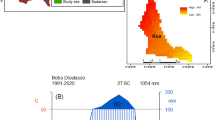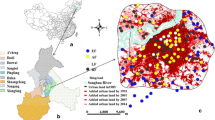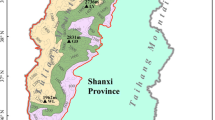Abstract
Differences in forest attributes and carbon sequestration of each organ and layer between broadleaved and conifer forests of central and outer urban areas are not well-defined, hindering the precise management of urban forests and improvement of function. To clarify the effect of two forest types with different urbanization intensities, we determined differences in vegetation composition and diversity, structural traits, and carbon stocks of 152 plots (20 m × 20 m) in urban park forests in Changchun, which had the largest green quantity and carbon density effectiveness. We found that 1.1-fold thicker and healthier trees, and 1.6- to 2.0-fold higher, healthier, denser, and more various shrubs but with sparser trees and herbs occurred in the central urban forests (p < 0.05) than in the outer forests. The conifer forests exhibited 30–70% obviously higher tree aboveground carbon sequestration (including stem and leaf) and 20% bigger trees, especially in the outer forests (p < 0.05). In contrast, 1.1- to 1.5-fold higher branch stocks, healthier and more diverse trees were found in broadleaved forests of both the inner and outer forests (p < 0.05). Plant size and dominant species had similarly important roles in carbon stock improvement, especially big-sized woody plants and Pinus tabuliformis. In addition, a higher number of deciduous or needle species positively affected the broadleaved forest of the central urban area and conifer forest of the outer urban area, respectively. These findings can be used to guide precise management and accelerate the improvement of urban carbon function in Northeast China in the future.











Similar content being viewed by others
References
Ali A, Lin S, He J, Kong F, Yu J, Jiang H (2018) Climate and soils determine aboveground biomass indirectly via species diversity and stand structural complexity in tropical forests. For Ecol Manage 432:823–831. https://doi.org/10.1016/j.foreco.2018.10.024
Ali A, Lin S, He J, Kong F, Yu J, Jiang H (2019) Big-sized trees overrule remaining trees’ attributes and species richness as determinants of aboveground biomass in tropical forests. Glob Change Biol 25(8):2810–2824. https://doi.org/10.1111/gcb.14707
Baker M, Roviello V, Kroeger D, Roviello G (2022) Old growth forests and large old trees as critical organisms connecting ecosystems and human health. A Rev Environ Chem Lett 20(2):1529–1538. https://doi.org/10.1007/s10311-021-01372-y
Bastin J, Rutishauser E, Kellner J, Saatchi S, Pélissier R, Hérault B, Slik F et al (2018) Pan-tropical prediction of forest structure from the largest trees. Glob Ecol Biogeogr 27(11):1366–1383. https://doi.org/10.1111/geb.12803
Carretero E, Moreno G, Duplancic A, Abud A, Vento B, Jauregui J (2017) Urban forest of Mendoza (Argentina): the role of Morus alba (Moraceae) in carbon storage. Carbon Management 8(3):237–244. https://doi.org/10.1080/17583004.2017.1309206
Chang Y, Wang Z, Zhang D, Fu Y, Zhai C, Wang T, Yang Y, Wu J (2022) Analysis of urban woody plant diversity among different administrative districts and the enhancement strategy in Changchun City. China Sustainability 14(13):7624. https://doi.org/10.3390/su14137624
Dimri S, Baluni P, Sharma C (2017) Biomass production and carbon storage potential of selected old-growth temperate forests in Garhwal Himalaya, India. Proc Natl Acad Sci India Sect b: Biol Sci 87(4):1327–1333. https://doi.org/10.1007/s40011-016-0708-0
Dong S, Sha W, Su X, Zhang Y, Li S, Gao X, Liu S, Shi J, Liu Q, Hao Y (2019) The impacts of geographic, soil and climatic factors on plant diversity, biomass and their relationships of the alpine dry ecosystems: Cases from the Aerjin Mountain Nature Reserve, China. Ecol Eng 127:170–177. https://doi.org/10.1016/j.ecoleng.2018.10.027
Escobedo F, Kroeger T, Wagner J (2011) Urban forests and pollution mitigation: analyzing ecosystem services and disservices. Environ Pollut 159(8–9):2078–2087. https://doi.org/10.1016/j.envpol.2011.01.010
Fan W, Zhang H, Yu Y, Mao X, Yang J (2011) Comparison of three models of forest biomass estimation. Chin J Plant Ecol 35(4):402–410. https://doi.org/10.3724/sp.j.1258.2011.00402
Fu W, Fu Z, Ge H, Ji B, Jiang P, Li Y, Wu J, Zhao K (2015) Spatial variation of biomass carbon density in a subtropical region of Southeastern China. Forests 6(12):1966–1981. https://doi.org/10.3390/f6061966
Gratani L, Varone L, Bonito A (2016) Carbon sequestration of four urban parks in Rome. Urban Forestry & Urban Greening 19:184–193. https://doi.org/10.1016/j.ufug.2016.07.007
Guo Z, Fang J, Pan Y, Birdsey R (2010) Inventory-based estimates of forest biomass carbon stocks in China: A comparison of three methods. For Ecol Manage 259(7):1225–1231. https://doi.org/10.1016/j.foreco.2009.09.047
Hu Y, Su Z, Li P, Li W (2015) Comparative studies on biomass-carbon accounting models at forest stand scale. J Central South Univ For Technol 35(1):84–88
Jin T, Liu W, Wang Y, Zhao M, Fu Y, Dong Y, Luo T, Fu H, Wang Q (2022) Effects of urbanization intensity on glomalin-related soil protein in Nanchang, China: Influencing factors and implications for greenspace soil improvement. J Environ Manage 318:115611. https://doi.org/10.1016/j.jenvman.2022.115611
Kashiwagi H (2016) Atmospheric carbon dioxide and climate change since the Late Jurassic (150Ma) derived from a global carbon cycle model. Palaeogeogr Palaeoclimatol Palaeoecol 454:82–90. https://doi.org/10.1016/j.palaeo.2016.04.002
Kendal D, Egerer M, Byrne J, Jones P, Marsh P, Threlfall C, Allegretto G, Kaplan H, Nguyen HK, Pearson S, Wright A, Flies EJ (2020) City-size bias in knowledge on the effects of urban nature on people and biodiversity. Environ Res Lett 15(12):124035. https://doi.org/10.1088/1748-9326/abc5e4
Klein T, Niu S (2014) The variability of stomatal sensitivity to leaf water potential across tree species indicates a continuum between isohydric and anisohydric behaviours. Funct Ecol 28(6):1313–1320. https://doi.org/10.1111/1365-2435.12289
Knorn M, Moisen G, Healey S, Keeton W, Freeman E, Hostert P (2011) Evaluating the Remote Sensing and Inventory-Based Estimation of Biomass in the Western Carpathians. Remote Sens 3(7):1427–1446. https://doi.org/10.3390/rs3071427
Lin J, Kroll C, Nowak D, Greenfield E (2019) A review of urban forest modeling: Implications for management and future research. Urban For Urban Greening 43:126366. https://doi.org/10.1016/j.ufug.2019.126366
Lindenmayer D, Laurance W (2017) The ecology, distribution, conservation and management of large old trees. Biol Rev Camb Philos Soc 92(3):1434–1458. https://doi.org/10.1111/brv.12290
Liu C, Xiang W, Lei P, Deng X, Tian D, Fang X, Peng C (2013) Standing fine root mass and production in four Chinese subtropical forests along a succession and species diversity gradient. Plant Soil 376(1–2):445–459. https://doi.org/10.1007/s11104-013-1998-0
Lutz J, Furniss T, Johnson D, Davies S, Allen D, Alonso A, Teixeira K et al (2018) Global importance of large-diameter trees. Glob Ecol Biogeogr 27(7):849–864. https://doi.org/10.1111/geb.12747
Ma J, Li X, Jia B, Liu X, Li T, Zhang W, Liu W (2021) Spatial variation analysis of urban forest vegetation carbon storage and sequestration in built-up areas of Beijing based on i-Tree Eco and Kriging. Urban For Urban Greening. https://doi.org/10.1016/j.ufug.2021.127413
Ma K, Liu C, Yu S, Wang W (1997) Plant community diversity in Dongling Mountain, Beijing, China III. Species-abundance relations of several types of forest communities. Acta Ecologica Sinica 17(6):573–583. https://www.plant-ecology.com/EN/Y1999/V23/I6/490
Marshall J, Waring R (1984) Conifers and broadleaf species: stomatal sensitivity differs in western Oregon. Can J for Res 14(6):905–908. https://doi.org/10.1139/x84-161
Mitchell M, Johansen K, Maron M, McAlpine C, Wu D, Rhodes J (2018) Identification of fine scale and landscape scale drivers of urban aboveground carbon stocks using high-resolution modeling and mapping. Sci Total Environ 622–623:57–70. https://doi.org/10.1016/j.scitotenv.2017.11.255
Ni J (2013) Carbon storage in Chinese terrestrial ecosystems: approaching a more accurate estimate. Clim Change 119(3):905–917. https://doi.org/10.1007/s10584-013-0767-7
Nizamani M, Harris A, Cheng X, Zhu Z, Jim C, Wang H (2021) Positive relationships among aboveground biomass, tree species diversity, and urban greening management in tropical coastal city of Haikou. Ecol Evol 11(17):12204–12219. https://doi.org/10.1002/ece3.7985
Pelt R, Sillett S, Kruse W, Freund J, Kramer R (2016) Emergent crowns and light-use complementarity lead to global maximum biomass and leaf area in Sequoia sempervirens forests. For Ecol Manage 375:279–308. https://doi.org/10.1016/j.foreco.2016.05.018
Poorter L, Bongers F (2006) Leaf traits are good predictors of plant performance across 53 rain forest species. Ecology 87(7):1733–1743. https://doi.org/10.1890/0012-9658(2006)87[1733:ltagpo]2.0.co;2
Ren Z, Zheng H, He X, Zhang D, Shen G, Zhai C (2019) Changes in spatio-temporal patterns of urban forest and its above-ground carbon storage: Implication for urban CO2 emissions mitigation under China’s rapid urban expansion and greening. Environ Int 129:438–450. https://doi.org/10.1016/j.envint.2019.05.010
Seto K, Shepherd J (2009) Global urban land-use trends and climate impacts. Curr Opin Environ Sustain 1(1):89–95. https://doi.org/10.1016/j.cosust.2009.07.012
Shen G, Wang Z, Liu C, Han Y (2020) Mapping aboveground biomass and carbon in Shanghai’s urban forest using Landsat ETM+ and inventory data. Urban For Urban Greening 51:1226655. https://doi.org/10.1016/j.ufug.2020.126655
Sota C, Ferreira R, García R, Alvarez S (2019) Urban green infrastructure as a strategy of climate change mitigation. A case study in northern Spain. Urban Forestry & Urban Greening 40:145–151. https://doi.org/10.1016/j.ufug.2018.09.004
Trogisch S, Schuldt A, Bauhus J, Blum J, Both S, Buscot F, Izaguirre N et al (2017) Toward a methodical framework for comprehensively assessing forest multifunctionality. Ecol Evol 7(24):10652–10674. https://doi.org/10.1002/ece3.3488
Wang W, Zu Y, Wang H, Matsuura Y, Sasa K, Koike T (2005) Plant biomass and productivity of larix gmelinii forest ecosystems in northeast China: intra- and inter- species comparison. Eurasian J. Forest Res Hokkaido Univ (Japan) 8(1):21–41
Wang W, Zhang B, Xiao L, Zhou W, Wang H, He X (2018) Decoupling forest characteristics and background conditions to explain urban-rural variations of multiple microclimate regulation from urban trees. PeerJ 6:e5450. https://doi.org/10.7717/peerj.5450
Wang W, Zhang B, Zhou W, Lv H, Xiao L, Wang H, Du H, He X (2019a) The effect of urbanization gradients and forest types on microclimatic regulation by trees, in association with climate, tree sizes and species compositions in Harbin city, northeastern China. Urban Ecosyst 22(2):367–384. https://doi.org/10.1007/s11252-019-0823-9
Wang Q, Wang W, Zhong Z, Wang H, Fu Y (2019b) Variation in glomalin in soil profiles and its association with climatic conditions, shelterbelt characteristics, and soil properties in poplar shelterbelts of Northeast China. J For Res 31:279–290. https://doi.org/10.1007/s11676-019-00909-w
Wang Y, Yu J, Xiao L, Zhong Z, Wang Q, Wang W (2020a) Dominant species abundance, vertical structure and plant diversity response to nature forest protection in Northeastern China: conservation effects and implications. Forests 11(3):295. https://doi.org/10.3390/f11030295
Wang Q, Zhang D, Zhou W, He X, Wang W (2020b) Urbanization led to a decline in glomalin-soil-carbon sequestration and responsible factors examination in Changchun, Northeastern China. Urban For Urban Greening 48:126506. https://doi.org/10.1016/j.ufug.2019.126506
Wang Y, Wen H, Wang K, Sun J, Yu J, Wang Q, Wang W (2021a) Forest plant and macrofungal differences in the Greater and Lesser Khingan Mountains in Northeast China: A regional-historical comparison and its implications. J For Res 33:623–641. https://doi.org/10.1007/s11676-021-01313-z
Wang Y, Chang Q, Li X (2021b) Promoting sustainable carbon sequestration of plants in urban greenspace by planting design: A case study in parks of Beijing. Urban For Urban Greening 64:127291. https://doi.org/10.1016/j.ufug.2021.127291
Wang H, Cai Y, Deng W, Li C, Dong Y, Zhou L, Sun J et al (2023) The effects of tree canopy structure and tree coverage ratios on urban air temperature based on ENVI-Met. Forests 14(1):80. https://doi.org/10.3390/f14010080
Wang Y, Wang B, Wang K, Wang H, and Wang W (2022) Land Degradation Neutrality: Achieving SDG 15 by Forest Management, Nature Conservation Effects on Forest Carbon Sequestration, Biodiversity of Plants, and Macrofungi: A Case Study in Central Lesser Khingan Mountains, NE China.
Weissert L, Salmond J, Schwendenmann L (2016) Photosynthetic CO2 uptake and carbon sequestration potential of deciduous and evergreen tree species in an urban environment. Urban Ecosyst 20(3):663–674. https://doi.org/10.1007/s11252-016-0627-0
Wu L, Shi Y, Zhang F, Zhou Y, Ding Z, Lv S, Xu L (2022) Estimating carbon stocks and biomass expansion factors of urban greening trees using terrestrial laser scanning. Forests 13(9):1389. https://doi.org/10.3390/f13091389
Yang Z, Zheng Q, Zhuo M, Zeng H, Hogan J, Lin T (2021) A culture of conservation: How an ancient forest plantation turned into an old-growth forest reserve – The story of the Wamulin forest. People Nat 3(5):1014–1024. https://doi.org/10.1002/pan3.10248
Yuan Z, Ali A, Benito P, Jucker T, Mori A, Wang S, Zhang X et al (2020) Above- and below-ground biodiversity jointly regulate temperate forest multifunctionality along a local-scale environmental gradient. J Ecol 108(5):2012–2024. https://doi.org/10.1111/1365-2745.13378
Zhang H, Qi Z, Ye X, Cai Y, Ma W, Chen M (2013) Analysis of land use/land cover change, population shift, and their effects on spatiotemporal patterns of urban heat islands in metropolitan Shanghai, China. Appl Geogr 44:121–133. https://doi.org/10.1016/j.apgeog.2013.07.021
Zhang D, Wang W, Zheng H, Ren Z, Zhai C, Tang Z, Shen G, He X (2017) Effects of urbanization intensity on forest structural-taxonomic attributes, landscape patterns and their associations in Changchun, Northeast China: Implications for urban green infrastructure planning. Ecol Ind 80:286–296. https://doi.org/10.1016/j.ecolind.2017.05.042
Zhang J, Wang W, Du H, Zhong Z, Xiao L, Zhou W, Zhang B, Wang H (2018) Differences in community characteristics, species diversity, and their coupling associations among three forest types in the Huzhong area, Daxinganling Mountains. Acta Ecol Sin 13:4684–4693. https://doi.org/10.5846/stxb201706261149
Acknowledgements
We would like to thank Z.W., J.W., X.Z., Y.Y. for their dedication to our fieldwork campaigns.
Author information
Authors and Affiliations
Corresponding author
Additional information
Publisher's Note
Springer Nature remains neutral with regard to jurisdictional claims in published maps and institutional affiliations.
Project funding: This work was supported by the Youth Growth Technology Project, Science and Technology Department of Jilin Province (20230508130RC), and project from Bureau of Forestry and Landscaping of Changchun.
Corresponding editor:Yu Lei
The online version is available at https://link.springer.com/.
Supplementary Information
Below is the link to the electronic supplementary material.
Rights and permissions
Springer Nature or its licensor (e.g. a society or other partner) holds exclusive rights to this article under a publishing agreement with the author(s) or other rightsholder(s); author self-archiving of the accepted manuscript version of this article is solely governed by the terms of such publishing agreement and applicable law.
About this article
Cite this article
Wang, Y., Dai, X., Chen, X. et al. Effects of urbanization and forest type on species composition and diversity, forest characteristics, biomass carbon sink, and their associations in Changchun, Northeast China: implications for urban carbon stock improvement. J. For. Res. 35, 36 (2024). https://doi.org/10.1007/s11676-023-01688-1
Received:
Accepted:
Published:
DOI: https://doi.org/10.1007/s11676-023-01688-1




